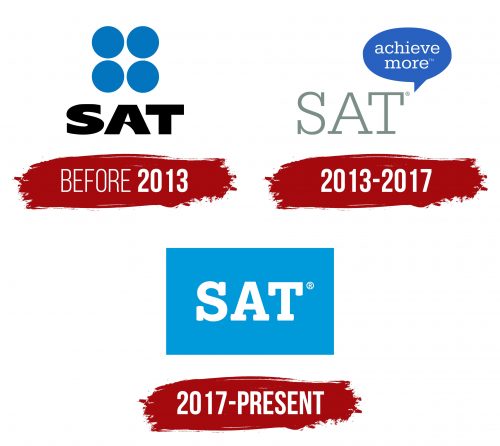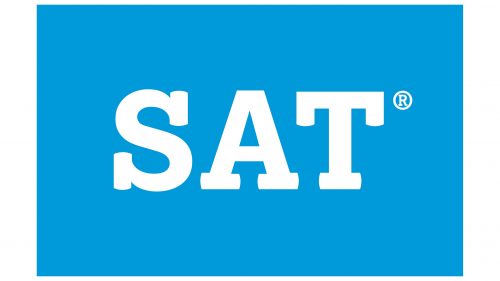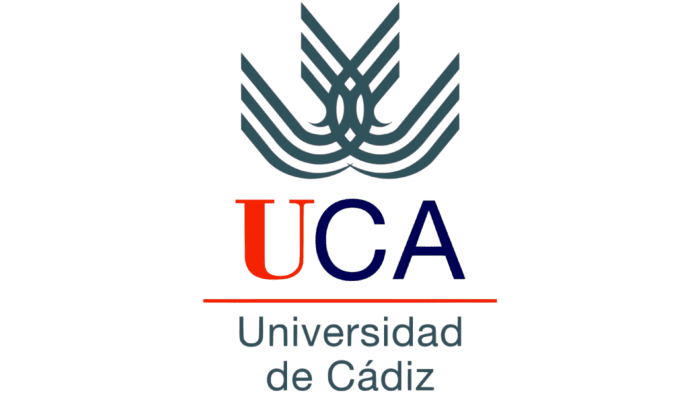The SAT logo has long been recognizable among Americans and students worldwide. The Scholastic Assessment Test revolutionized the education system, becoming an important tool for assessing applicants’ knowledge levels. With its wide range of questions and essays, the SAT objectively evaluates candidates’ academic potential. The abbreviation SAT, widely used in official and everyday conversations, has remained a key element of the logo throughout various historical periods. In the current version of the logo, these three letters take center stage.
The white letters are neatly arranged in the logo’s center, aligned in a row with a slight upward stretch and even spacing between them. The serifs on the letters give them a sense of solidity, symbolizing the depth and strength of the knowledge the test assesses. The blue background evokes associations with the sky, creating an atmosphere of calm and confidence. This choice was deliberate: the logo is meant to instill confidence in applicants and motivate them to demonstrate their knowledge rather than evoke fear of the exam. This approach highlights the importance of the SAT as an entrance exam that opens doors to America’s top universities.
SAT: Brand overview
The SAT’s (Scholastic Aptitude Test, subsequently renamed Scholastic Assessment Test) history dates back to the 1920s and is intimately associated with the growth of American higher education.
The College Board gave out the first SAT in 1926. The test, created by psychologist Carl Brigham and originally known as the Scholastic Aptitude Test, was created to evaluate student’s academic readiness for college entrance regardless of their financial situation or the caliber of their high school education.
The first test lasted 97 minutes and had 315 questions. It contained sections on reading paragraphs, arithmetic, classification, language, antonyms, analogies, and logical deduction. About eight thousand pupils took part in the initial administration.
In 1930, the assessment was split into verbal and mathematical components. This arrangement persisted for many years and represented the test’s distinctiveness.
The test’s popularity increased greatly in the 1940s. It became the common entrance exam for all Ivy League universities in 1942. This decision greatly enhanced its standing and significance in the US higher education system.
By the 1950s, most private schools and institutions in the United States began using the exam. As the number of candidates increased following World War II, the test became an increasingly important tool for student selection.
The test was criticized in the 1960s for what was thought to be cultural bias. In response, the College Board started trying to enhance the exam and make it more inclusive.
The Test of Standard Written English (TSWE), an addition to the exam, was first offered in the 1970s. This exam evaluated the writers’ abilities.
The framework underwent major modifications throughout the 1980s. The test was extensively altered in 1994, and the new name became the Scholastic Assessment Test, eventually shortened to SAT. Longer reading passages were incorporated, calculators were permitted in the math section, and certain problems were eliminated from the multiple-choice format.
Another change occurred in 2005. An essay and a writing section were added, and the points system was modified from 1600 to 2400.
Revisions were announced in 2015 and went into effect in 2016. The exam’s material was more closely aligned with what is taught in schools, the essay was made optional, and the scoring scale was reset to 1600 points. Penalties for wrong answers were eliminated.
The updated version went into effect in March 2016. Among the changes were:
- A return to the 1600-point rating system (reading and writing at 800 and math at 800).
- The essay was made optional and given a separate mark.
- Elimination of fines for giving false information.
- They revised exam questions to more closely align with academic courses.
- A focus on analysis in the writing and reading portions.
The College Board launched the “SAT School Day” project in 2018 to increase test accessibility by enabling students to take the exam on a regular school day.
The “Environmental Context Dashboard,” later dubbed “Landscape,” was unveiled in 2019. This approach gave colleges access to extra data about an applicant’s school and community to contextualize results.
The global pandemic of 2020 brought about many changes. Numerous test session cancellations led to more universities making the test optional for admission.
The College Board declared in January 2021 that the optional essay and SAT Subject Tests would no longer be offered. This choice was made in response to evolving demands from universities and students.
International students began taking the exam in a digital format in 2022, and all test-takers are expected to switch completely to a digital version by 2024. The digital version will last roughly two hours instead of three, have shorter reading sections, and permit calculator use throughout the math portion.
The test has been criticized and revised throughout its existence. Opponents cited its possible bias against particular student populations and the possibility that children from richer backgrounds may have easier access to preparation materials.
Despite the criticism, the SAT remains one of the most popular college entrance exams in the United States of America. Millions of students take the annual test as a college admission requirement.
Therefore, the history of the SAT reflects the development of the US higher education system, shifts in the perception of intellectual ability, and the pursuit of an equitable college admissions evaluation system.
Meaning and History
What is SAT?
This is a standardized exam used in the United States for college admissions. The College Board administers the exam, which measures students’ reading, writing, and math skills to determine whether they are ready for college. In addition to the two main math sections and the evidence-based reading and writing sections, the exam also includes an essay section. The total score out of 1600 is obtained by adding the scores for each component. Along with extracurricular activities, personal essays, and high school grades, many colleges and universities use exam scores as one of many criteria in the admissions process. The exam assesses critical thinking and problem-solving skills, which are critical to postsecondary education success.
Before 2013
The test has undergone a long and significant journey of transformations, gradually becoming one of the most popular in America. Today, millions of students take it annually. The SAT has its unique logo, which stands out notably from others, such as the ACT. However, the formation of its identity started simply: the goal was to create a logo that most accurately represented the Scholastic Assessment Test. Three colors were used to achieve this idea. White served as the background, black letters formed the main elements of the logo, and blue was applied for the precise graphic rendering of four geometric shapes. These shapes, small circles, took a central place on the emblem of the test, rising above the abbreviation.
The letters were written in bold font, making them wide and noticeable. Special attention was drawn to the letter “A” with its extended diagonal line, giving the logo an extravagant look. Its original design made the logo easily recognizable and memorable, which played a key role in its popularity.
2013 – 2017
2013, the identity underwent significant changes, becoming more informative and vibrant. In addition to the updated tone, a new font was used, and most importantly, the logo featured a unique element that represents an important informational block.
The white background remains unchanged, maintaining its effect of purity and brightness. This color highlights each letter and draws attention to it. Now, the letters are written in a neat gray, which looks neutral and elegant against the previously used black tone. The width of the letters has been reduced, making the abbreviation more refined without losing its expressiveness. Gray and white colors harmonize, creating a unique combination of reliability, experience, and knowledge.
As a complex but effective knowledge assessment system, the test requires a logo that reflects its essence. Therefore, the new version of the logo includes a graphic element in the shape of a cloud. This element, filled with blue, highlights 11 white letters forming the slogan “Achieve More!” This slogan serves as a call to action and confirms students’ high trust in the test. Including this slogan enhances the informativeness and appeal of the logo, making it even more understandable and inspiring for future students.
2017 – today
The modern SAT logo can confidently be called informational and functional, stripped of excess and unnecessary elements. This emblem fully reflects the high status of the test, emphasizing its significance and reliability. Today, the test is considered one of the most effective ways of assessing knowledge, and the logo accurately conveys this idea — strict and restrained. It seems to suggest that knowledge will be thoroughly evaluated, and weak points will be identified. This highlights the test’s perfection, achieved through years of development and various transformations.
The new logo lacks a slogan, as the main perception of the test is now solely based on knowledge assessment. A calm gray background and three white superscript letters are concise and powerful symbols of the Scholastic Assessment Test. This design communicates that the focus remains solely on the core — knowledge, which will be evaluated fairly and objectively. Those striving for excellence will earn their deserved scores, and the logo, in turn, reflects this undeniable truth, making it modern and perfectly aligned with its purpose.







